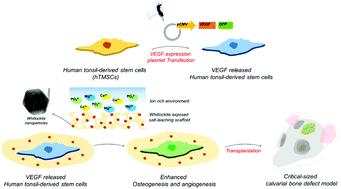当前位置:
X-MOL 学术
›
Biomater. Sci.
›
论文详情
Our official English website, www.x-mol.net, welcomes your
feedback! (Note: you will need to create a separate account there.)
Bioinspired inorganic nanoparticles and vascular factor microenvironment directed neo-bone formation.
Biomaterials Science ( IF 5.8 ) Pub Date : 2020-05-06 , DOI: 10.1039/d0bm00041h Hwan D Kim 1 , Jungha Park 1 , Sivashanmugam Amirthalingam 2 , R Jayakumar 2 , Nathaniel S Hwang 3
Biomaterials Science ( IF 5.8 ) Pub Date : 2020-05-06 , DOI: 10.1039/d0bm00041h Hwan D Kim 1 , Jungha Park 1 , Sivashanmugam Amirthalingam 2 , R Jayakumar 2 , Nathaniel S Hwang 3
Affiliation

|
Various strategies have been explored to stimulate new bone formation. These strategies include using angiogenic stimulants in combination with inorganic biomaterials. Neovascularization during the neo-bone formation provides nutrients along with bone-forming minerals. Therefore, it is crucial to design a bone stimulating microenvironment composed of both pro-angiogenic and osteogenic factors. In this respect, human vascular endothelial growth factor (hVEGF) has been shown to promote blood vessel formation and bone formation. Furthermore, in recent years, whitlockite (WH), a novel phase of magnesium-containing calcium phosphate derivatives that exist in our bone tissue, has been synthesized and applied in bone tissue engineering. In this study, our aim is to explore the potential use of hVEGF and WH for bone tissue engineering. Our study demonstrated that hVEGF and a WH microenvironment synergistically stimulated osteogenic commitment of mesenchymal stem cells both in vitro and in vivo.
中文翻译:

受生物启发的无机纳米粒子和血管因子微环境指导新骨形成。
已经探索了各种策略来刺激新的骨形成。这些策略包括将血管生成刺激剂与无机生物材料结合使用。新骨形成过程中的新血管形成提供了营养以及骨形成矿物质。因此,设计由促血管生成和成骨因子组成的骨刺激微环境至关重要。在这方面,已经显示出人血管内皮生长因子(hVEGF)促进血管形成和骨形成。此外,近年来,已经合成了在我们的骨组织中存在的新型相镁土磷灰石(WH),并将其应用于骨组织工程中。在这项研究中,我们的目的是探索hVEGF和WH在骨组织工程中的潜在用途。
更新日期:2020-03-17
中文翻译:

受生物启发的无机纳米粒子和血管因子微环境指导新骨形成。
已经探索了各种策略来刺激新的骨形成。这些策略包括将血管生成刺激剂与无机生物材料结合使用。新骨形成过程中的新血管形成提供了营养以及骨形成矿物质。因此,设计由促血管生成和成骨因子组成的骨刺激微环境至关重要。在这方面,已经显示出人血管内皮生长因子(hVEGF)促进血管形成和骨形成。此外,近年来,已经合成了在我们的骨组织中存在的新型相镁土磷灰石(WH),并将其应用于骨组织工程中。在这项研究中,我们的目的是探索hVEGF和WH在骨组织工程中的潜在用途。









































 京公网安备 11010802027423号
京公网安备 11010802027423号